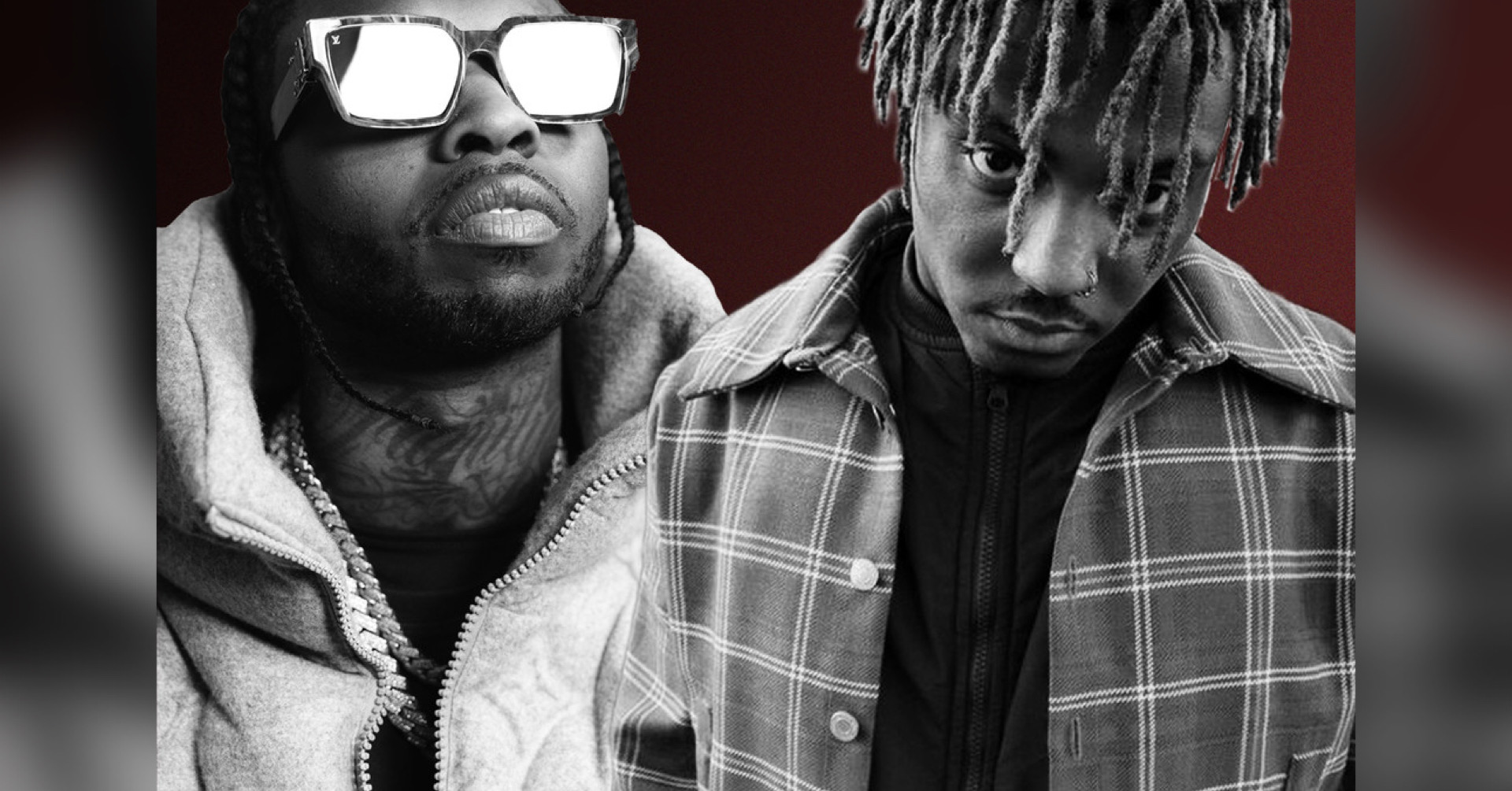(July 18, 2020). A recent trend suggests that – despite the record-breaking, phenomenal success of hip-hop music over the past several years – rappers are also on the wrong side of history when it comes to a particular chart statistic.
That historic trend is this: Hip-hop artists have accounted for more than half of the No. 1 albums by solo artists that have occurred posthumously during the past 25 years – that is, albums that have either moved up to or debuted at the No. 1 position on the Billboard 200 after the artist’s death, since 1995.
Contributing to that number are two albums by late rappers that will make history this coming week when Juice WRLD’s Legends Never Die replaces Pop Smoke’s Shoot for the Stars, Aim for the Moon at No. 1 on the next Billboard 200.

The numbers are in, and all projections indicate that Juice WRLD’s album earned in the neighborhood of 508,000 album-equivalent units during the tracking week that ended Friday, July 17 – more than enough to place it at No. 1 on the next chart (dated July 25 and to be officially announced on Sunday, July 19th).
When that happens, it’ll be the first time in history that two posthumous albums have hit No. 1 in consecutive weeks. It’ll also be the third posthumous No. 1 in a row by a rapper, following the late XXXTentacion’s Skins, which topped the chart in December 2018.
What’s sad about this statistic is that all three rappers – JuiceWRLD (born Jarad Anthony Higgins), Pop Smoke (real name Bashar Barakah Jackson) and XXXTentacion (born Jahseh Dwayne Ricardo Onfroy) – were just 20 or 21 years of age when they lost their lives to senseless acts (murder by gun violence for XXX and Smoke; drug overdose for Juice) and they were all young men approaching the primes of their careers at the times of their deaths.
Violence affecting the hip-hop community is certainly nothing new. Just earlier this month (July 11), rapper Lil Marlo – another rising star from the Atlanta hip-hop scene – was gunned down on Interstate 285. This follows the high profile deaths of Pop Smoke in February and Huey, a rapper out of St. Louis, who was fatally shot outside his home on June 25. And that’s not to mention the countless other young rappers – male and female -who’ve succumbed to gun violence or drugs in the past few years. Even rising superstar Megan Thee Stallion isn’t immune to gun violence as she counts herself among those lucky to be alive after being shot just last weekend (she’s expected to make a full recovery).
It was only a matter of time before the law of averages caught up to what had been, until now, a relatively exclusive club of deceased artists – mostly legendary rock musicians – who’d gone on to have a No. 1 album after their deaths. Now, just like nearly every other metric involving music consumption in America, hip-hop artists rule this category as well.
The last time an album reached No. 1 posthumously by a non-hip-hop artist was when Prince topped the list in May 2016 with The Very Best of Prince, a collection that ascended to the top following the artist’s then-recent passing from an accidental drug overdose at his Paisley Park studios. Nearly four months before that, David Bowie’s last studio album debuted in the top spot after his death. It was an album released on his 69th birthday – just two days before his untimely passing from cancer. His surprising death spurred sales and made Blackstar a posthumous No. 1 a week later.
There was a time during the Rock and Roll Era – which began in 1955 – that posthumous No. 1 albums were extremely rare. During rock’s first 40 years – from 1955-94 – only three artists had ever achieved posthumous No. 1s on the Billboard 200: Janis Joplin (Pearl in 1971), Jim Croce (You Don’t Mess Around with Jim in 1974), and John Lennon (Double Fantasy with his wife Yoko Ono in 1980).
Then in 1995, the untimely death at age 23 of Tejano pop singer Selena Quintanilla (who, like Lennon, was gunned down by a deranged fan) made her the first artist with a posthumous No. 1 album (Dreaming of You) since the ex-Beatle fifteen years earlier.

Then came the violent deaths of legendary rappers Tupac Shakur (1996) and The Notorious B.I.G. (1997) in successive years, each of whom joined this dubious No. 1 club during the year of their deaths (The Don Killuminati: The 7 Day Theory for 2Pac under the alias Makaveli; and Life After Death for Biggie).
These two eventual Rock and Roll Hall of Fame inductees each followed up with two subsequent posthumous No. 1 albums, giving the rival bicoastal rappers six such albums between them. At three each, Pac and Biggie remain the only artists of any genre with more than one posthumous chart topper.
It’s those six albums by 2Pac and Biggie, plus the three recently added No. 1s by XXXTentacion, Smoke, and now Juice WRLD, which give hip-hop nine of the last sixteen albums by solo artists to posthumously reach No. 1. Besides the names already mentioned, the other non-rappers on this list include Aaliyah, Elvis Presley, Ray Charles, and Michael Jackson.
Here’s the running tally of late solo artists with posthumous No. 1s and the dates they first achieved them (including a pre-rock era entry by bandleader Glenn Miller):
| No. | Artist | Date of Death | Date of first posthumous No. 1 | First posthumous No. 1 title |
| 1 | Glenn Miller | 12/15/1944 | 05/22/1954 | Glenn Miller Plays Selections from “The Glenn Miller Story” |
| 2 | Janis Joplin | 10/04/1970 | 02/27/1971 | Pearl |
| 3 | Jim Croce | 09/20/1973 | 01/12/1974 | You Don’t Mess Around With Jim |
| 4 | John Lennon | 12/08/1980 | 12/27/1980 | Double Fantasy |
| 5 | Selena | 03/31/1995 | 08/05/1995 | Dreaming of You |
| 6 | 2Pac | 09/13/1996 | 11/23/1996 | The Don Killuminati: The 7 Day Theory – Makaveli |
| 7 | The Notorious B.I.G. | 03/09/1997 | 04/12/1997 | Life After Death |
| 8 | Aaliyah | 08/25/2001 | 09/15/2001 | Aaliyah |
| 9 | Elvis Presley | 08/16/1977 | 10/12/2002 | ELV1S: 30#1 Hits |
| 10 | Ray Charles | 06/10/2004 | 03/05/2005 | Genius Loves Company |
| 11 | Michael Jackson | 06/25/2009 | 11/14/2009 | This Is It |
| 12 | David Bowie | 01/10/2016 | 01/30/2016 | Blackstar |
| 13 | Prince | 04/21/2016 | 05/07/2016 | The Very Best of Prince |
| 14 | XXXTentacion | 06/18/2018 | 12/22/2018 | Skins |
| 15 | Pop Smoke | 02/19/2020 | 07/18/2020 | Shoot for the Stars, Aim for the Moon |
| 16 | JuiceWRLD | 12/08/2019 | 07/25/2020* | Legends Never Die |
Note: for editorial purposes, this list does not include artists who were part of multi-act soundtrack albums or groups who reached No. 1 after key individual members died. For the latter reason, groups like Allman Brothers Band (Berry Oakley), Nirvana (Kurt Cobain), A Tribe Called Quest (Phife Dawg) and the Beatles (Lennon, George Harrison) – all of whom reached No. 1 with albums that included deceased key members (named in parentheses) – are not included in this tally.
As you can see, almost all of the deceased artists on this list reached No. 1 within a year of their passing, with the notable exceptions being Glenn Miller and Elvis Presley. Elvis took the longest – 25 years – to reach No. 1 after his death. Ironically, his only grandson – also a musician – took his own life just this past week at age 27.
This is a sad commentary indeed, and not one the hip-hop community likes to commemorate. It is life’s cruelest joke that many of these artists didn’t get to enjoy the fruits of their labor while they were on this side. If we could have Biggie and Pac back – or Juice, Smoke and X for that matter – we know there is so much more these young men would have had to say, both on record and in life.
That all of them managed to have No. 1 albums after their deaths speaks volumes. But the fact that none of these rappers lived to see their 26th birthdays speaks even louder.
May they all continue resting in eternal peace!
DJRob
DJRob is an African-American freelance blogger from Chicago who covers R&B, hip-hop, pop and rock genres – plus lots of music news and current stuff! You can follow him on Twitter @djrobblog.
You can also register for free to receive notifications of future articles by visiting the home page (see top for menu).



[…] 18, 2021). Precisely one 12 months in the past at this time, the weblog posted an article about how late rapper Pop Smoke (born Bashar Barakah Jackson) was a part of chart historical past […]